"Discollects" of the Third Reich
Herr Fock Patent
Back in 1939, Heinrich Fokke, the chief designer of Fokke-Wulf, filed a patent application for a new aircraft concept. In the application, he was named simply: “a plane with the possibility of vertical take-off”. On the surviving drawings for the authorship of Focke, you can see the approximate layout of this device. Most of the design is wing. Its front edge has a parabolic shape, and its rear edge is straight, with a backward sweep. The thickness of the wing profile is quite large and in the central part is comparable to the height of the fuselage. The latter is neatly inscribed in the design of the wing. In fact, the Fokke device designed for vertical take-off is a flying wing, from which only a drop-shaped cockpit in the front and a keel in the rear protrude. But the main nuance of the design lies in the middle part of the combined wing-fuselage.
In the central part of the aircraft there is a round channel of large diameter, passing through the entire thickness of the wing. There are two coaxial screws, rotating in different directions. The drive of screws was supposed to be carried out with the help of engines located in the rear part of the apparatus. The gearbox, providing rotation of the screws towards each other, obviously, had to be mounted in a common fairing of the hubs of the screws. As conceived by Focke, the screws were supposed to work both as lifting and as propulsion engines. In connection with the original propeller group is worth considering a control system. For almost the entire length of the trailing edge of the wing, the vertical takeoff plane had elevons for roll and pitch control. The keel housed the rudder. In general, nothing special for tailless aircraft. However, another original control was directly connected to the screws. The lower exit of the channel of screws was closed by special shutters. In the parking lot, they were closed, and in flight it was supposed to change their position. This was done in order to change the thrust vector of the propellers. In addition, it is worth noting that in the available diagrams, the screws are located not parallel to the horizontal axis of the device, but with an inclination forward. Due to this arrangement, they in the take-off and landing position provide vertical traction, compensating for the features of the parking position (three-point chassis with a crutch). After being taken off the ground, the pilot, controlling the doors of the exit orifice, had to place the device in a horizontal position. In this case, the plane of rotation of the screws was at an angle to the horizon and further, using the same sashes, it was possible to control the thrust vector and the flight speed. When landing, respectively, the pilot had to transfer the plane from horizontal flight to hover mode, bring the pitch angle to the parking value and, smoothly dropping thrust, make a touch and landing.
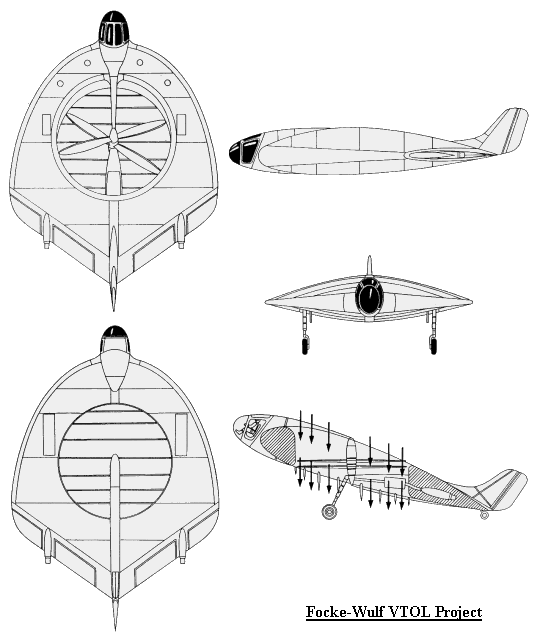
There is information about the conducted purging models of this device in wind tunnels. In addition, sometimes there are assertions about the existence of small models, made in accordance with the proposal of G. Focke. After the war, the patent and related documentation fell into the hands of the Allies. The project aroused considerable interest, which subsequently resulted in research on the subject of a parabolic or round in terms of the wing and vertical takeoff vehicles. There is no data on the existence of at least a full-size model of this aircraft. However, the “vertical take-off aircraft” is well known to aviation historians under the name Fokke Wulf VTOL (Vertical Take-Off and Landing). It should be noted that the term VTOL comes from English. Why do they designate a German project? The fact is that in the German documentation there is no designation for this aircraft, besides the definition of the possibility of a vertical take-off.
From model to aircraft
In the same year 1939, the first national competition of model aircraft was held. Among others, a young farmer Arthur Sak, whose hobby was aviation, offered his model airplane with an internal combustion engine. His plane AS-1 had an unusual wing. The unit in a span of 125 centimeters was round in plan shape. As planned by Saka, such a wing layout could provide the aircraft with good lift values and, as a result, maneuverability, controllability and carrying capacity. The model weighing four and a half kilograms was equipped with a weak petrol engine. Because of this, AS-1 was able to fly a test distance of one hundred meters, but its speed made you forget about the prizes. However, in the end, Sack received a more interesting "prize".
Ernst Udet himself was present at the competition, by that time he had become one of the main people in the Luftwaffe. He became interested in the original wing of the model and suggested that Saku continue work on this topic in more suitable conditions for research. The following years were spent on the study of the disk wing in wind tunnels, the search for the optimal profile and a lot of other things. According to the results of these studies, with a break of several months, four models with indices from AS-2 to AS-5 were built. From each other, they differed design features, as well as size. In the autumn of 1943, the project of A. Saka reached the stage when it was possible to begin creating a full-size manned prototype.
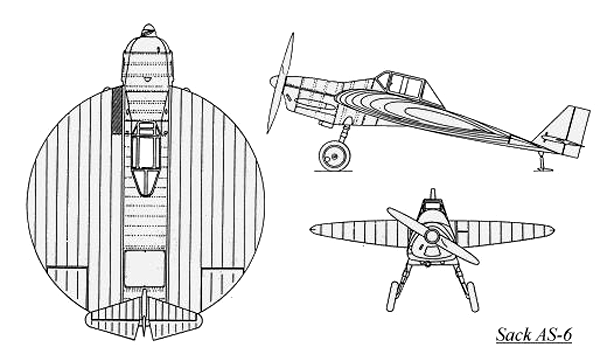
For the assembly of the prototype aircraft, Saku identified the Flugplatz-Werkstatt workshops at Brandis airfield, where construction began at the end of 43. The manned aircraft with a disc-shaped wing was designated AS-6. Under the leadership of a former farmer, the workshop workers assembled the original wing. Three spars carried on themselves eight ribs and fastened to the frame of the fuselage. In addition, an additional power element was mounted along the edge of the wing, the purpose of which was to ensure the rigidity of the edges of the bearing plane. The wooden structure of the wing with metal fasteners was completely new, which is not the case with other aircraft components. The Argus As-10C-3 petrol engine (240 hp), along with part of the engine mount and hood, was borrowed from the Bess-108 Taifun light Messerschmitt. The chassis, the cockpit, the lantern and a number of other parts were removed from the crashed Bf-109B fighter. As for the tail, this knot was redone, albeit with extensive use of elements of existing aircraft.
If you compare the design of the AS-6 with other aircraft of the time, then it is distinguished only by the shape of the wing and its power set. The rest of the Saka aircraft was similar to many other designs. Is that the dashboard AS-6 had a spartan look - only six instruments. Control of the aircraft was carried out using standard for such technology controls. The pilot had at his disposal control knobs, aircraft controls, and pedals. To control the pitch on the stabilizer there was a rudder, the pedals were connected with the rudder, and the ailerons of the original form were placed on the rear edge of the wing.
In February, 1944, the testing of the experimental aircraft began. They began with runs. In general, these tests were found to be satisfactory, although the low efficiency of the steering wheels caused complaints. In addition, the units removed from the crashed aircraft were not very reliable and had to be repaired constantly. After all repairs, taxiing was continued. During the second stage of ground checks it turned out that the reason for the low effectiveness of the tail rudder lies in their location. Because of the original design of the wing - with a large length of the root part - the rudders found themselves in a zone of reduced pressure that went beyond the planes. In addition, during the last run on the runway, the landing gear fell off. Another repair followed, this time a larger one, because the wing suffered during the “braking”.
The new calculations showed that AS-6 was first of all due to its failures due to the weak engine. At the disposal of A. Saka there were no other engines, so it was decided to increase the angle of attack. The most obvious way to do this is to move the landing gear. But the dense layout of power elements and units inside the fuselage did not allow to do this. Therefore, reworking the landing gear touched the installation of the brakes (taken from a Ju-88 bomber) and the installation of a balancing weight in 70 kg on the third spar, as well as additional aerodynamic surfaces on the trailing edge of the wing. Now, according to the calculations of the designers, the plane had to have the desired angle of attack during the takeoff run. The improvements made have resulted. The third series of rulezekh showed increased efficiency of the rudders, and the plane now and then "rushed up." The first flight was scheduled for the fourth test phase. Pilot G. Baltabol pushed the throttle to the end forward and began to run. After separation, the plane began to roll to the side. The pilot managed to release the gas and gently land. The reason for this was simple: a wing of small elongation and ailerons of a small area could not effectively counter the reactive torque of the propeller. Since this problem was a direct consequence of the very concept of the AS-6 aircraft, Baltabol refused to continue testing until the introduction of the corresponding corrections. The pilot most complained about the weak engine and the lack of efficiency steering. Finally, he advised another month or two to work in a wind tunnel and only then begin flight tests.
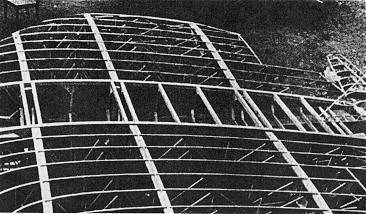
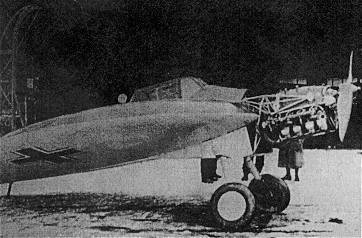
Arthur Sack returned to the curtain and wind tunnel. While he was working to improve the car, in the summer of 44, I was transferred to the Brandis airfield with an I / JG400 regiment, whose pilots flew Me-163 fighters. The pilots of the 400 squadron had a good experience of flying heavy planes, so they were immediately interested in AS-6. It was the combatant pilots who invented the aircraft with a round wing the nickname Bierdeckel - “Tray for beer”. And one of the pilots even volunteered to conduct a test flight. Lieutenant F. Rosette made several runs and a small approach. When the ground touched, AS-6 again lost the landing gear, and the disgruntled Rozle left exactly the same recommendations that Baltabol had previously given.
The AS-6 debugging lasted almost to the end of the war. Saku was helped by the engineers of several design bureaus, but all this did not have the proper effect. In April, the 45 of the experienced AS-6 was severely damaged during the bombing of the Brandis airfield. When American troops captured the airfield, they did not find any parts or remains of the aircraft. Probably, the wreckage of the car were dismantled and disposed of as unnecessary.
Belonza, Zimmerman and others ...
The Fokke-Wulf VTOL and AS-6 projects have one thing in common: their existence is confirmed by documents and photographs (this applies only to the latter). However, other German aircraft, which cannot “boast” with similar evidence of their existence, often receive more attention from fans of the original aviation technology.
It all began in the 50s, when R. Luzar’s book “The Secret weapon Third Reich. It talked about some disc-shaped miracle devices that could take off to an altitude of 12-15 kilometers and accelerate to two or four thousand kilometers per hour. And they showed all this in the first flight. It was from this book that the public learned about some fundamentally new “Schauberger engine”, which allowed German aircraft, in particular, the notorious “Belonts disk”, to have such outstanding characteristics. The book Luzar cited the scheme and even muddy, blurred photos of these "flying saucers." True, there was not a single reference to known documents. Therefore, the Secret Weapon of the Third Reich soon became the favorite publication of various lovers of secrets and mysteries.
In search of the "secret development" of Germany, sometimes it comes to ridiculous. So, sometimes in the list of German "flying saucers" is a kind of "flying damn Zimmerman." It is said that the German engineer Hans (in some sources, Heinrich) Zimmerman, even in 1943, created a disc-shaped aircraft with outstanding characteristics. Various citations of alleged witnesses who allegedly were present at the tests, etc. are given. We have to admit that the “Zimmerman pancake” really existed. Only there are a few "but." First, Zimmerman was called Charles. Secondly, he worked at the American firm Chance Vought. Thirdly, the “flying pancakes” were officially named V-173 and XF5U. Finally, Zimmerman’s planes, called “Blinin” and “Shumovka”, respectively, are widely known to aviation enthusiasts and are not a special mystery. But it is already completely different. story.
On the materials of the sites:
http://luft46.com/
http://airwar.ru/
http://german-ufo.com/
http://membrana.ru/
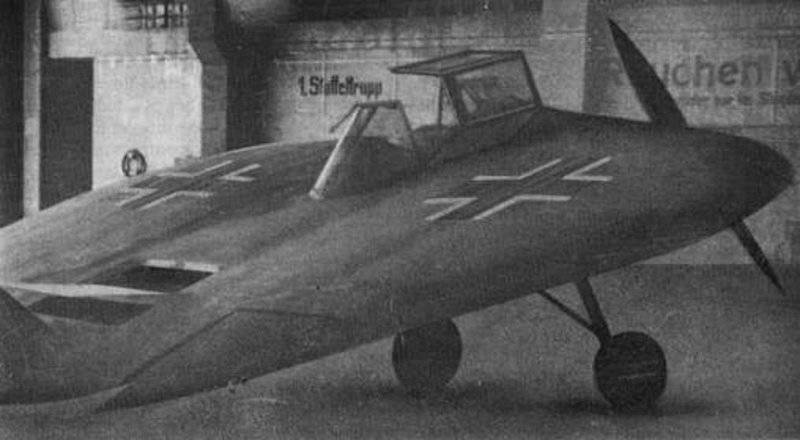
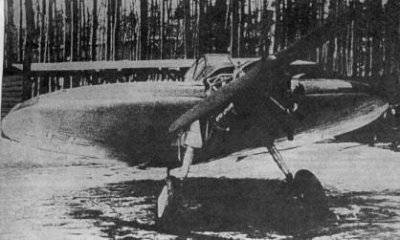
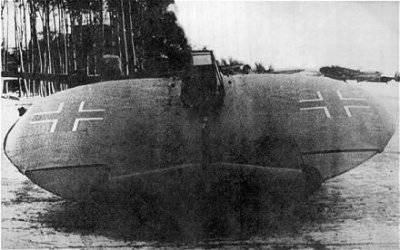
Information